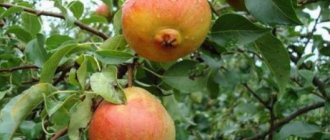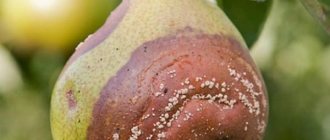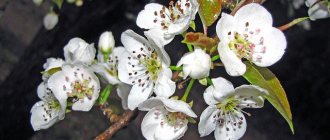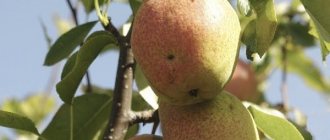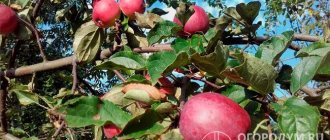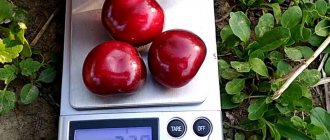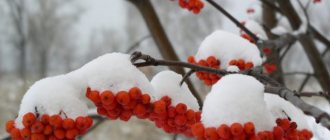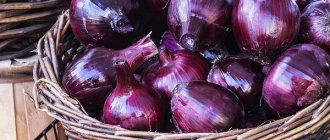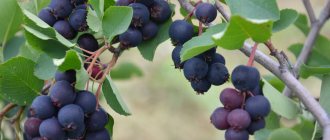Scientists have made great strides in creating new winter-hardy late-ripening pear varieties. The result of such work is the Wonderful pear, the fruits of which are preserved for a long time. Descriptions, photos and reviews of the Wonderful pear will allow you to grow a pear orchard without much effort and be content with a fresh harvest all winter.
Description of the pear variety Chudesnitsa
Breeding work to create a new form of the Chudesnitsa pear, characterized by special climate resistance for the Central Black Earth District, was carried out by scientists from the All-Russian Research Institute of Horticulture named after I.V. Michurin by crossing the varieties Talgarskaya Krasavitsa and Daughter of the Dawn.
The Chudesnitsa pear tree of medium growth vigor forms a pyramidal spreading crown, up to 3 meters high. Smooth, straight shoots are brown in color and lack pubescence. The plant is decorated with green leaves, finely jagged along the edges, which are ovoid in shape with a pointed tip. White flowers consist of 5 petals. The heart is bulbous, the seed chambers are closed. The seeds are medium-sized, conical, brown in color.
Breeding history
Selection work, thanks to which the popular hybrid was obtained, was carried out at the All-Russian Research Institute of Genetics and Selection of Fruit Plants named after. I.V. Michurina. Daughter of Dawn and Talgarskaya were used as mother plants. The authors are considered to be scientists S.P. Yakovleva, N.I. Savelyeva, A.P. Gribanovsky.
The hybrid was registered in 2001 and entered into the State Register three years later. It is zoned in the Central Black Earth region, but today it is successfully grown in the Moscow region, Leningrad and Voronezh regions, Ukraine, Belarus and Kazakhstan.
Fruit characteristics
The large-sized fruits of the Chudesnitsa pear tree, which weigh from 150 to 210 g, attract attention. The fruits have a truncated cylindrical-conical shape and a flat, smooth surface. The peel is characterized by oiliness and the presence of a thin waxy coating.
Fruits at the moment of removable ripeness are colored light green with a faint pink blush. As it ripens, the skin acquires a golden hue with a diffuse reddish tan. The fruits are held on the stems by a curved stalk of medium thickness. The flesh is creamy in color and has an oily texture. The taste is sweet, slightly sour. The sugar content in the fruit is 9.6%, and the acidity level is 7.9 g/l. Ripe fruits emit a delicate floral aroma, thanks to which the Chudesnitsa pear variety has gained particular popularity.
Pests
The main danger is pests:
- brown fruit mite;
- blue-headed armyworm;
- goose;
- mole.
Brown fruit mite
Brown fruit mites overwinter in cracks in the bark, and in the spring they molt and lay eggs on the leaves. In less than a month, the larvae become adult ticks. The cycle is repeated many times.
To combat brown fruit mites in the spring, the tree is sprayed with acaricides. The drug used is changed so that ticks do not develop immunity to it. If the lesions are too severe, resort to the use of nitrafen or oleocuprite.
Blue-headed armyworm
It is a large butterfly with brown wings that lays eggs in the crown of trees for the winter. To combat it, the branches are regularly inspected and the caterpillars are shaken off, followed by the destruction of the pest.
If the invasion of the blue-headed armyworm is widespread, the tree is treated with insecticides. Do this before flowering.
Late varieties of pear Paten (Glubokskaya, Talgarskaya krasavitsa, Belorusskaya late)
How to keep winter pear varieties fresh
goose
In spring, hawthorn caterpillars eat buds, leaves and flowers. Female apple growers lay eggs in the buds (on average, one female can lay up to a hundred eggs), as a result the petals stick together, after which the bud dries out. The pear leaf gall midge sucks juice from the leaves.
Mole
No less dangerous for the variety is the fruit moth. In case of a large-scale invasion, the tree remains without leaves. To prevent this, fruit trees are sprayed with an infusion of hot pepper.
Pros and cons of Chudesnitsa pear variety
The Chudesnitsa pear variety, although developed not so long ago, has already fallen in love with many gardeners for a number of advantages:
- stable and annual yield, evenly distributed over the years;
- attractive appearance of pears and decent taste properties;
- good transportability, in which pears do not lose their presentation;
- the harvest is distinguished by its keeping quality, allowing pears to be stored for 4-5 months;
- the versatility of the purpose of fruits, which are good not only fresh, but also suitable for home preparation and industrial production;
- compact size of the tree, which makes pruning and harvesting easier;
- maximum winter hardiness and the ability to quickly recover after severe frosts;
- excellent resistance to diseases characteristic of this variety;
- low demands on cultivation conditions.
In addition to the large number of advantages of the Chudesnitsa pear variety, there are also disadvantages, which include:
- the need for frequent pruning, therefore, much attention should be paid to the process of crown formation, since intensive plant growth is observed,
- the tasting score is only 4.3 points.
Advantages and disadvantages of the variety
- It’s not for nothing that the Bryansk Beauty variety is loved by domestic gardeners, because it has a lot of significant advantages:
- high frost resistance;
- presentation of fruits and their excellent transportability;
- excellent taste of pears;
- good immunity to scab and fungal diseases;
- self-pollinating ability of a plant, the ability to bear fruit without the presence of pollinating plants;
- natural resistance to most garden pests;
- rapid fruiting, after 3–5 years.
- Experienced gardeners also note some disadvantages of the crop:
- low resistance to drought;
- Unstable yield indicators during self-fertile pollination.
Optimal growing conditions
Photos and descriptions of the Chudesnitsa pear variety will help create comfortable conditions for the growth of a pear orchard. The favorable period for planting fruit crop seedlings is spring and autumn. Planting dates are determined depending on the climate conditions of the growing region.
For the Middle Zone, spring planting is recommended. Over the course of the season, the young tree will grow stronger and accumulate strength to endure the harsh winter. In the southern regions, pears can be planted in the fall, but this should be done a month before the first frost. The optimal planting dates are autumn - mid-September, spring - end of April.
The ideal place for planting is a dry, flat area where solar energy is in harmony with a light wind. The tree develops and bears fruit well on clay and loamy soil, rich in nutrients. It is necessary that the soil be characterized by looseness, this will ensure excellent air circulation.
Characteristics
January is very prolific; with proper and regular pruning, you will always have an excellent harvest.
Pears begin to ripen in mid-September, this largely depends on the climate. January plant is grown in large quantities in the central regions of Russia.
In these places, the following varieties of pears are also successfully grown: Pamyati Zhegalova, Tonkovetka, Cathedral, Ilyinka and Rogneda.
It is very important to pick the fruit at the right time. If you pick unripe pears, they will quickly harden, will not be juicy, and will spoil much faster.
The same thing happens if pear fruits are stored at too low a temperature.
You can eat pears immediately after picking them, but they become tastier after about one to two weeks after lying at a temperature of about 20 degrees.
In refrigerator conditions, that is, at zero temperature, these pears can be stored for up to four months.
Pears are a very healthy product, but as you know, these fruits are quite heavy on the stomach, and therefore it is not recommended to consume them in large quantities.
January is rich in ascorbic acids and pectin.
Trees are quite difficult to endure winter, especially if there are severe frosts. After such weather conditions, frozen bark can be seen on the tree trunk.
If the tree's root system is not properly protected from the cold, its fertility will be significantly reduced.
January pears are very widely used. They are used according to various traditional medicine recipes. Also, the peel of this pear is a component of many medicines and is used for pharmacology.
Jams, preserves, and sauces made from the pulp of these fruits are suitable for consumption. Wine is made from pears, and there is also pear honey. Some people dry the January fruits or make delicious sweets - candied fruits.
Planting and caring for the Chudesnitsa pear
The Chudesnitsa pear variety requires attention from the gardener, competent planting, regular care and provision of comfortable conditions for growth. In order for the tree to fully develop and the harvest to be abundant, the plant must be planted correctly, as well as all necessary care measures must be carried out. And in September you will be able to enjoy the excellent taste of healthy fruit.
Landing rules
Proper planting of the Chudesnitsa pear variety is a guarantee of the successful development and favorable existence of the pear tree, therefore it is necessary to carry out the following procedure:
- Dig a hole of dimensions that should allow the root system of the young tree to be located freely in the planting hole without bending or creasing the roots.
- The bottom of the pit is well loosened and equipped with a layer of fertile soil containing granular mineral fertilizers or organic substances.
- Before planting, you need to install a peg to securely support the plant.
- In the middle of the hole, make a mound of nutrient substrate and carefully place the seedling on it.
- Sprinkle with soil so that the root collar is 5 cm above the soil surface. Carefully tie the seedling to a stake. The garter is very important for annual specimens.
- Compact the soil near the trunk, water and mulch, using humus to eliminate moisture evaporation. At the same time, the growth of weed crops is suppressed and moisture evaporation is reduced.
Watering and fertilizing
To get a generous harvest of Chudesnitsa pears, you should surround the fruit tree with care, which consists of carrying out such important measures as observing soil moisture conditions and timely application of nutrients.
Watering should be carried out based on weather factors, soil type and plant age. After watering, loosen the soil around the tree to prevent crust formation.
It is also important to provide the Chudesnitsa pear variety with microelements through foliar and root feeding. The first application of nutrients should be carried out 3 years after planting, using mineral and organic substances depending on the time of year. To increase the winter hardiness of pears and stimulate the ripening of wood, fertilizers based on phosphorus and potassium should be applied in the fall.
Trimming
To prevent thickening of the crown, Chudesnitsa pears need to be pruned regularly. Thanks to this procedure, it is possible to adjust the crop's yield, sugar content and fruit size, and pruning will also make it easier to access the tree when picking fruit. Ignoring this event will lead to a decrease in yield.
Spring pruning involves removing damaged, old shoots; it is important to do this before sap flow begins. You also need to prune the plant in the autumn, leaving 2-3 fruiting shoots on the skeletal branch. After the event, the sections must be lubricated using garden varnish or oil paint.
Whitewash
Caring for the Chudesnitsa pear variety includes such an important event as whitewashing, this will protect the trees from sunburn. Since the white color in which the plant trunk is painted reflects the rays of the sun, overheating of the trunk becomes impossible. Also, whitewashing Chudesnitsa pears is an excellent protective method against various pests, since lime has a detrimental effect on insects.
Preparing for winter
According to the description, the Chudesnitsa pear variety is distinguished by good winter hardiness, allowing the crop to survive even the lowest temperatures (up to - 38 °C). Therefore, adult specimens tolerate harsh winters well without additional shelter. For young growth, the trunk should be wrapped in agrofibre, and the tree trunk circles should be mulched with a layer of humus, sawdust, and peat. A good way to protect yourself from the cold is to use fallen snow that can be used to cover a tree.
Landing rules
In order for the Wonderful pear to grow fully and produce a stable harvest, you need to follow certain rules for planting and placing it in the garden plot. Ignoring these standards will result in crop productivity being lower than stated.
Recommended timing
Planting of the Wonderful pear can be done in the fall (from mid-September and during the first ten days of October) and in the spring (from mid to late April). The first option is preferable for central Russia, the second for the southern regions. When planting in the fall, it is necessary that the pear seedling has time to fully take root before winter, so it should be done a month before persistent frosts.
In the spring, it is also not recommended to delay planting, since elevated air temperatures start the growing season, which negatively affects the development of the root system.
Site selection and soil preparation
It is recommended to place the Miracle Pear in open sunny areas, protected from drafts. The distance relative to other trees should be about 5-6 m. In this case, the groundwater level should be at least 2.5 m from the soil surface.
Wonderful pear is undemanding to the composition of the soil, but prefers black soil or loam.
Selection and preparation of seedlings
For planting, it is recommended to choose annual and biennial seedlings with a height of 70-90 cm, which guarantees rapid rooting in a new location. Also, according to experts, it is worth choosing specimens with a clearly defined tap root, as they have increased endurance. For the Southern regions, it is preferable to select a pear grafted onto a quince.
Important! The bark of a young seedling should not show signs of deformation or damage.
Before planting, the root system of the plant must be immersed in water for 24 hours to start the process of active growth.
Landing algorithm
When planting Chudesnitsa pear, you must follow the general rules, as for other varieties. In this case, the planting hole should be prepared two weeks in advance and filled with a special mixture. This will provide the pear with the necessary nutrition at the initial stage of development.
Composition of the nutritional mixture:
- one part is river sand;
- two parts – turf soil;
- one part is peat;
- one part is rotted manure;
- 150 g – potassium sulfate;
- 75 g – superphosphate.
Important! Nitrogen fertilizers cannot be added when planting pears, as this negatively affects the development of the root system.
Landing algorithm:
- Straighten the root system of the seedling and remove all damaged and broken areas.
- Place the plant in the center of the hole so that the root collar is 5 cm above the soil level.
- Place a 1 m high peg nearby.
- Sprinkle with soil, shaking the seedling periodically to fill the voids.
- Compact the soil at the base.
- Tie the pear to the peg.
- Water thoroughly at the rate of 20 liters per seedling.
The next day after planting, loosen the soil in the tree trunk circle and mulch it with a layer of peat 3-5 cm thick.
Productivity
The yield is ensured by an appropriate genetic basis and is increased due to a rational tree placement scheme, appropriate agricultural cultivation technology, and a system of protection against diseases and pests. Pears of the Chudesnitsa variety begin to bear fruit 5-6 years after planting the seedling. The average yield of the variety is more than 130 c/ha.
The Chudesnitsa variety of pears should be harvested at the end of September, but in order to obtain a quality product, the fruit should be sent to the fruit storage facility for ripening within 30-40 days.
Description and characteristics
Traditionally, the description of any variety of fruit tree includes the botanical characteristics of the tree, as well as the commercial qualities of the fruit, because both play a role in deciding whether to plant a plant on your site.
Description of the tree
The Miracle Tree is distinguished by the following features:
| Height | 2.5–3 m (medium height) |
| Crown | Pyramidal, compact, medium density |
| Bark | Brown with a brown tint, tubercles (lentils) few in number |
| Branches | Straight, thick, smooth |
| Kidneys | Small, compact, symmetrical, cylindrical at the base, tapering towards the end into a cone |
| Leaves | Rich green color, matte. The shape is ovoid with a pointed end and small teeth along the edges. The plate is flat and smooth, curved upward at the apex. The veins are not clearly visible |
| petiole | Short |
| Stipules | In the form of an awl |
| foliage | Average |
| Flowers | Small, white, five-petalled |
Did you know? Springerle (Springerle) - the famous German cookies with an image in the form of relief - are prepared using special molding boards, which are traditionally made only from pear wood.
Description of fruits
Among the features of Chudesnitsa pears, the following main points should be highlighted:
| Form | Truncated-conical, elongated in length. The funnel is in the shape of a blunt cone, the saucer is medium. |
| Dimensions | Quite large, on average 130–200 g |
| Peel color | Green with a diffuse pink side, but during ripening it changes to amber-yellow. There may be some rust on the funnel. |
| Peel structure | Dense, smooth, slightly lumpy, covered with a shiny waxy coating. Subcutaneous points are clearly visible. |
| Flesh color | Milky white |
| Pulp structure | Tender, very juicy, semi-buttery, medium density and grain |
| Seeds | Brown-brown in color, medium in size and cylindrical in shape, located in small closed chambers |
| peduncle | Medium length, curved at an angle of 75° to the fruit |
| Taste | Sweet and sour with a pronounced fruity aroma, no viscosity or astringency. Sugar content - 9.6%, acid - 7.9% |
| Tasting rating (on a five-point scale) | 4,3 |
Flowering and fruiting times
Like other autumn-ripening pears, Miracle begins to bloom around the beginning of May, when the likelihood of late spring frosts is already low. The harvest reaches technical ripeness in early September, biological ripeness after about 2 weeks.
Typically, pears of this variety are picked green and left to ripen for 30 days. This allows you to protect the crop from shedding and extend its shelf life.
A young seedling begins to bear fruit approximately in the fifth year after planting, which is considered a good indicator for a pear, and, with good care, this can last for 5–7 decades.
Variety resistance
Miracle has excellent winter hardiness. During selection tests, the tree was subjected to freezing in laboratory conditions to a temperature of -38°C, which is practically unrealistic for the middle zone to which the variety is aimed.
The result turned out to be very impressive: the bark and main tissues of the Miraculous were not damaged at all by the frost, and the educational tissue (the so-called cambial layer) suffered only slightly.
Important! The declared characteristics of the variety as winter-hardy led to the attempts of some gardeners to plant Chudesnitsa in regions with obviously more severe winters than the authors of the variety planned. The experiments were unsuccessful: the pear wood was severely damaged by frost.
Miraculous also has good immunity to fungal diseases and pests; in particular, scab, rust and pear borer - the worst enemies of the orchard - almost do not affect this variety.
The tree's resistance to adverse weather conditions is another merit of the authors of the Miraculous.
Diseases and pests
Getting a good harvest depends on timely implementation of measures to combat diseases and pests.
According to the description, the Chudesnitsa pear variety is resistant to various fungal diseases. But for prevention purposes, it is necessary to spray trees with specially designed preparations, following the dosage recommended by the manufacturer when preparing the products.
The Miraculous pear variety is also favored by pests: green aphids, pear copperhead. These insects secrete sticky excrement (honeydew), as a result the fruits become small and lose their presentation. A proven folk method using a soap-kerosene solution will help you cope with the problem. Proper care and compliance with sanitary standards will reduce the likelihood of the appearance and development of parasites.
Aftercare
The main condition for obtaining a generous harvest is regular pruning of shoots. Therefore, immediately after planting, you should shorten the main trunk at a height of 50-60 cm, and the side branches by 1/3 of the length. In the future, it is worth regularly clearing the crown of thickening shoots. An adult tree should have three well-developed skeletal branches, from which 2-3 fruit shoots should extend.
After planting the Miraculous pear, you need to constantly monitor the soil moisture. Lack of moisture at an early stage of development leads to drying out of the root system. In the absence of seasonal precipitation, watering should be carried out a couple of times a week at the rate of 20 liters of water per seedling.
In the first year after planting, there is no need to fertilize the pear if a nutrient mixture has been added to the planting hole. Subsequently, it is better to fertilize three times a season:
- during the active growing season;
- during the formation of buds;
- during flowering.
In the first two stages it is worth using nitrogen-phosphorus fertilizers, and in the third - phosphorus-potassium fertilizers.
Advice! To protect the tree trunk from rodents, it is recommended to cover it with a metal mesh at a distance of 3-5 cm from the bark.
The adult Miraculous pear does not suffer from low temperatures, but young seedlings need additional insulation for the winter. To do this, it is necessary to mulch the tree trunk circle with peat 10 cm thick in the fall. It is also recommended to wrap the lower part of the trunk with burlap or agrofibre.
Pests and diseases
Wonderful pear has increased resistance to common fungal diseases. Therefore, it is enough only to carry out preventive treatment with “Fundazol” or “Skor” in order to preserve the plant’s immunity.
This variety is susceptible to the negative effects of green aphids and pear suckers. Therefore, it is recommended to spray pears with Bi-58 solution in spring and autumn after harvesting.
Reviews from gardeners about the Chudesnitsa pear
Reviews about Miracle pears are only positive. This variety of crop belongs to varieties that do not require special care. Gardeners note the high winter hardiness of the plant: pear trees tolerate cold, little snow winters without reducing productivity. The pear does not require rich soils; it grows well and bears fruit in extreme conditions.
An attractive feature of the Chudesnitsa pear is considered to be its early entry into fruiting; in comparison with other pear varieties that bear fruit in 6-7 years, the Chudesnitsa forms a harvest already in the 5th year of life. Another positive quality, according to gardeners, is the long shelf life of fruits. Pears ripened at the beginning of autumn are perfectly stored for 4-5 months.
Care
The miracle worker does not require complex care:
- trees are undemanding when it comes to moisture, however, this does not mean that they do not need to be watered. Watering is carried out as needed. Stagnation of moisture is unacceptable;
- It is advisable to keep the soil around fruit trees clean, collecting organic debris and removing weeds, because this is where the larvae of insect pests can be found;
- the soil must be loosened so that there is always a free supply of oxygen to the roots;
- A mandatory maintenance procedure is tree pruning, through which the crown is thinned and formed;
- Wonderful trees respond well to fertilization. The plants are fed three times per season. In the spring it is best to apply nitrogen-containing fertilizers, in the summer phosphorus and potassium are preferable, and in the fall the soil around the trees is fed with organic substances - rotted cow manure, chicken droppings or humus;
- In the spring, before the start of the growing season, trees are treated once with special preparations against diseases and pests.
Characteristics of the variety
According to the description, the Chudesnitsa pear variety is characterized by:
- good winter hardiness (tolerates temperatures of -38°C without freezing of the bark or damage to cambium tissue);
- high productivity;
- average fruiting (the tree bears fruit 5-6 years after planting);
- duration of consumption (fruits are stored for up to 4 months, provided that the room is cool);
- harvesting in the second and third decades of September; durability (gives harvests up to 50-70 years);
- not picky about soil;
- ripening of fruits in a plucked state to gain flavor and sweetness.
Description of the tree
According to the description, pears of the Kudesnitsa variety are vigorous. Their crown has an oval shape and an average level of density. The main disadvantage is the reduction of fruits due to thickening of the crown. The bush has a mixed type of fruiting. The shoots of this fruit tree are relatively thin and greenish-brown, with small buds and relatively small green leaves with a round, upward-curving shape.
The ideal time for planting pear seedlings is autumn, but you can also plant them in the spring, but in this case the planting holes are prepared in the fall.
Description of the fruit
The average fruit weight varies from 130 to 200 g. The shape is slightly elongated and regular. To the touch, the skin of the fruit is oily and smooth, with a slight waxy coating.
The fruits of this fruit tree are characterized by closed seed chambers. Small saucer, straight, medium-sized stalk. The seeds are also small and narrow. During the ripening period, the fruit has a rich yellow color, sometimes with a blurred blush.
The pulp is white and tender, most often oily. The fruit tastes sweet, with a slight sour taste, and has a faint aroma. This fruit is actively used to prepare certain types of wines and various sweets. It is also popular in folk medicine. It is sometimes used in the production of treatments for a number of viral diseases.
The Miracle Pear, as described by gardeners, does not require special care. All she needs is:
- access to direct sunlight (the best option for planting is the south or west side);
- preferably drained and fertile soils;
- moderate soil moisture, because excessive moisture and stagnation of moisture harm the fruit tree;
- mandatory pruning (any method will do: shortening, transferring to branches, thinning);
- optimal irrigation system - sprinkling with a sprayer that imitates natural rain;
- loosening to provide the soil with oxygen after watering;
- applying fertilizers in autumn and spring, starting from the second year;
- good insulation of the roots in the cold season, while the trunk is wrapped with film or paper.
The tree is easy to care for
If the tree grows in soil conditions with high levels of sand or clay, the soil must be prepared in advance. The best option is to change the land storage manually. This requires:
- purchase 2-3 bags of ready-made soil mixture for fruit trees;
- dig a small pit in the area planned for planting the crop;
- mix the soil taken from the pit with the prepared soil mixture in the proportion of 3 m of soil mixture per 1 m of local soil.
Part of the prepared mixture is placed at the bottom of the hole, and part is left to cover the roots of the seedling.
One of the main positive qualities of the Chudesnitsa variety is its resistance to disease.
It does not suffer from scab, which is widespread in temperate climates, which gives it a significant advantage in the market over other fruits. The tree is not affected by entomosporia, which negatively affects the formation of buds and gives the leaves a brown color.
The main danger is pests:
- brown fruit mite;
- blue-headed armyworm;
- goose;
- mole.
Brown fruit mite
Brown fruit mites overwinter in cracks in the bark, and in the spring they molt and lay eggs on the leaves. In less than a month, the larvae become adult ticks. The cycle is repeated many times.
To combat brown fruit mites in the spring, the tree is sprayed with acaricides. The drug used is changed so that ticks do not develop immunity to it. If the lesions are too severe, resort to the use of nitrafen or oleocuprite.
Blue-headed armyworm
It is a large butterfly with brown wings that lays eggs in the crown of trees for the winter. To combat it, the branches are regularly inspected and the caterpillars are shaken off, followed by the destruction of the pest.
If the invasion of the blue-headed armyworm is widespread, the tree is treated with insecticides. Do this before flowering.
Characteristics of the variety
The variety is suitable for cultivation in Ukraine, Belarus, and many regions of Russia. It is planted to obtain fruits for personal use and for sale.
Resistance to diseases and pests
With proper planting and care, trees have strong immunity to major diseases and harmful insects. They are almost never affected by scab and are well resistant to fruit rot, spotting, bacterial cancer, and powdery mildew. Fruits are not afraid of the codling moth.
Drought resistance and winter hardiness
Trees of the Sokrovische variety tolerate dry periods and frosts down to –20°C. However, it must be taken into account that the buds may not withstand temperatures dropping to –15°C.
Did you know? The largest recorded pear was grown in South Wales (UK) in 1979. The weight of the fetus was 1.405 kg.
Pollination
To ensure pear fruiting is abundant and stable, pollinating varieties should also be planted in the garden. For pollination of the Treasure pear, the following are best suited:
- Clapp's favorite;
- Conference;
- Williams;
- Bere Mlievskaya;
- Melting;
- Dean de Comis.
Flowering and ripening times
Flowering occurs in May. The fruits appear from the beginning of September and can ripen until mid-October (depending on the growing region).
Productivity of the variety
The first fruiting occurs in trees 4-5 years after planting. At first there are few fruits - up to 20 kg per tree, but subsequent harvests are stable and abundant. At 10 years old, the tree is capable of producing 100 kg of pears per season. The fruits ripen almost simultaneously and can remain ripe on the tree for a long time.
We recommend that you familiarize yourself with the features of growing autumn pear varieties:
Transportability
Thanks to the thick and dense peel, the fruits tolerate transportation well without losing their presentation and high taste characteristics.
The main positive and negative sides of the pear
The Chudesnitsa pear variety was appreciated by summer residents and farmers for its positive characteristics:
- frost resistance down to -38°C;
- crown decorativeness;
- dessert taste of fruits with a floral-pear aroma;
- compactness, low size of the tree, making it easier to care for and harvest;
- keeping quality, high transportability;
- long shelf life when fresh;
- versatility of use;
- high resistance to rust, scab, pests;
- stable fruiting;
- high, artificially created immunity.
Among the disadvantages of pears, they note the need for regular pruning, since with a thickened crown the plant does not have the strength to form full-fledged fruits. The second disadvantage is the need to plant pollinators nearby.
Characteristics of the variety
Fairytale pears have many positive characteristics that have allowed this variety to become very popular among both professional gardeners and amateurs.
Resistance to diseases and pests
Skazochnaya has a strong immunity to a wide variety of diseases, which distinguishes this variety from many others.
Equally important, disease resistance is not lost in different climates and growing conditions. Thus, pears of this variety are not affected by cancer, scab and rotten diseases, which means that the trees do not require chemical treatments. Important! Parts affected by disease or pests must not only be removed from the tree, but must also be burned
Important! Parts affected by disease or pests must not only be removed from the tree, but must also be burned
Drought resistance and winter hardiness
The Fairytale pear is distinguished by its high ability to withstand cold without significant damage. For example, in the winter of 1979, the maximum air temperature was recorded at –48°C. In such conditions, the freezing of the tree was only 2 points - this means that the trunk suffered no more than 25%. In addition, Skazochnaya is distinguished by its high ability to tolerate drought and recover easily.
Pollination
Skazochnaya is a self-fertile variety, which means these fruit trees are cross-pollinated - that is, the formation of fruits requires the presence of pollen from another variety of pears. Self-pollination in such cases triggers the process of combining female and male cells, which ultimately leads to a drop in fertility or its absence. The yield of self-fertile varieties is not affected by weather conditions, making them truly valuable in rainy or cold climate regions.
Important! A large number of fruit trees growing in one area ensures a high and stable yield. The process of cross-pollination takes place when combining varieties with early and medium flowering periods (not fruit ripening periods), as well as with medium and late
But varieties with early and late flowering most likely will not intersect. Please also note that the flowering period may vary depending on weather conditions.
The process of cross-pollination takes place when combining varieties with early and medium flowering periods (not fruit ripening periods), as well as with medium and late ones. But varieties with early and late flowering most likely will not intersect. You should also take into account that the flowering period may vary depending on weather conditions.
Flowering and ripening times
Typically, this variety blooms in mid-May, which reliably protects the future harvest from possible spring frosts. This date may be slightly delayed towards the end of the month in regions with cold climates. The period of fruit ripening begins in the second half of August, but is also very dependent on climatic conditions, as well as the composition of the soil and the quality of tree care procedures. The fragrant fruits reach their maturity in early September.
Productivity
Skazochnaya pears are early-fruiting varieties, and therefore the first harvest from a planted tree can be harvested already in the 2nd year of life. At this stage, the number of fruits will not be large, but already in the 5th–6th year the yield will increase and will be stably maintained at the level of 10–13 kg per tree. In general, this variety has an average yield, but without interruptions in fruiting. At the stage of technical ripening, the fruits have a bright green color, when ripe they have a yellow tint.
Transportability
Despite the fairly hard peel and dense stalk, which allows the fruit to stay on the branch and maintain its presentation, this variety does not have high transportability, and the shelf life of the fruit varies between 7–10 days. When harvesting, it is recommended to lay fruit in layers, covering each with soft material.
Did you know? According to an ancient Chinese superstition, sharing a pear with someone will lead to inevitable separation.
